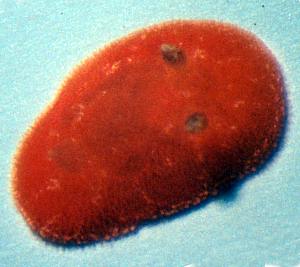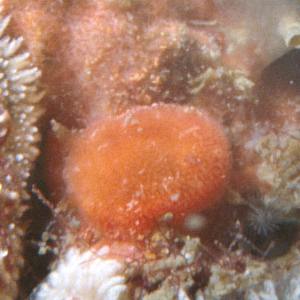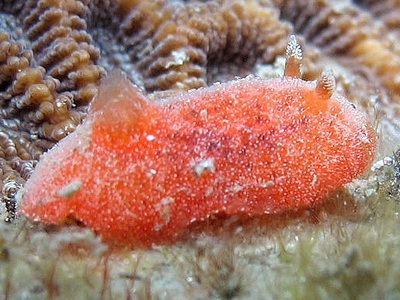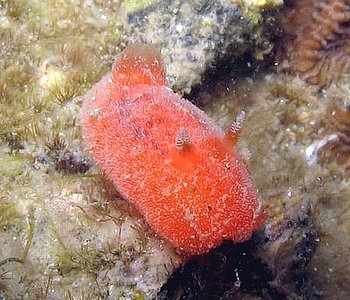

Rostanga dentacus
Rudman & Avern, 1989
Order: NUDIBRANCHIA
Suborder: DORIDINA
Superfamily: EUDORIDOIDEA
Family: Dorididae
PHOTO
W. side of Chek Chan, Mirs Bay, Hong Kong; 2-5 m, one specimen (6 mm long preserved), 13 April 1983, PARATYPE, AM C139173. Photos: Brian Darvell.
See also R. dentacus - Radula.
From the available colour photographs and field notes the body is a deep orange with brown specks on the basal mantle epithelium. There are also scattered white specks on the mantle skirt. The rhinophore stalk is transparent and the club is translucent white heavily speckled in brown with some white patches. The tip of the club is white. The gills are a translucent orange with a dusting of brown and some white specks especially near the edge. The animal is typical for the genus with a dense covering of caryophyllidia on the mantle and a circle of short erect gills. The rhinophore club is ovate with about five almost horizontal lamellae surmounted by a short rounded knob. No information on egg mass or developmental biology is available. The specimen from Heron Is. was found "on some sort of orange encrustation-sponge?" according to the collectors. Unfortunately the 'encrustation' was not collected. No information on the food of Hong Kong specimens is available.
Rostanga dentacus is one of the few species of Rostanga with horizontally arranged lamellae on the rhinophore club. The shape of the radular teeth is unique with all but the innermost tooth having long pointed non-denticulate cusps. The elongate innermost tooth has a few long pointed inner denticles. The name dentacus (Latin: dentis = tooth; acus = needle) refers to the shape of the teeth. At present the species is known from Hong Kong and the Great Barrier Reef, Queensland, suggesting a wide distribution, at least in the western Pacific.
Reference:
• Rudman, W.B. & Avern, G.J. (1989) The genus Rostanga Bergh, 1879 (Nudibranchia:
Dorididae) in the Indo-West Pacific. Zoological Journal of the Linnean Society 96: 281-338.
Rudman, W.B., 2002 (February 4) Rostanga dentacus Rudman & Avern, 1989. [In] Sea Slug Forum. Australian Museum, Sydney. Available from http://www.seaslugforum.net/find/rostdent
Related messages
Rostanga dentacus ? from Hong Kong
August 4, 2007
From: Felix Poon

I found this orange nudi on a coral. The skin is furry. Is it Rostanga arbutus?
Locality: Hoi Ha Wan, 3 m, Hong Kong, Indo Pacific, 16 Apr 2007, Intertidal, Coral. Length: 4 cm. Photographer: Felix Poon.
Felix Poon
ifex@hotmail.com
Poon, F., 2007 (Aug 4) Rostanga dentacus ? from Hong Kong . [Message in] Sea Slug Forum. Australian Museum, Sydney. Available from http://www.seaslugforum.net/find/20354
Dear Felix,
It is definitely a species of Rostanga. The 'furry' mantle and the compact, upright gills are good characters of that genus - as is the red colour, in most species. However identifying them to species just by looking at their external shape and colour is usually quite difficult except in certain parts of the world where there is only one species present. Even that needs to be said with caution because when I started looking at the 'single' species known from southeastern Australia, Rostanga arbutus, it turned out to be a complex of species all quite different in radular morphology, shape of egg ribbon, larval development, and choice of food. Since then I am always hesitant to identify a Rostanga just on ther shape and colour of the animal.
So what about your species? Specimens of Rostanga were often identified from many parts of the Indo-West Pacific as R. arbutus, but that species is restricted by its direct developing larvae to southeastern Australia. Of the three species I have reported from Hong Kong, we can ignore R. orientalis because it has rhinophores with vertical lamellae. However both the other two species, R. dentacus and R. bifurcata, have rhinophores similar in shape and colour to your animal. The only difference is that in R. bifurcata the rhinophore lamellae are slightly sloping. So at a guess I would say your animal is R. dentacus, but I emphasise that is a guess. Without a knowledge of their food or egg ribbon, these animals can only be positively identified by radular morphology.
-
Rudman, W.B., Avern, G. (1989) The genus Rostanga (Nudibranchia: Dorididae) in the Indo-West Pacific. Zoological Journal of the Linnean Society 96(3): 281-338.
Best wishes,
Bill Rudman
